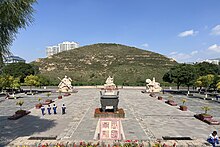
Back گونئی لیانق سولالهسی AZB Южна Лян Bulgarian Južni Liang BS Südliche Liang German Liang méridional French Nàm-Liòng HAK Južni Liang Croatian 南涼 Japanese 남량 Korean Өмнөд Лян Mongolian
Southern Liang (南涼) 西平 (397), 武威 (397–401), 河西 (401–404), 涼 (408–414) | |||||||||||
|---|---|---|---|---|---|---|---|---|---|---|---|
| |||||||||||
 | |||||||||||
 | |||||||||||
| Status | Vassal of Later Qin | ||||||||||
| Capital | Lianchuan (397–399) Ledu (399, 402–406, 410–414) Xiping (399–402) Guzang (406–410) | ||||||||||
| Government | Monarchy | ||||||||||
| Prince | |||||||||||
• 397–399 | Tufa Wugu | ||||||||||
• 399–402 | Tufa Lilugu | ||||||||||
• 402–414 | Tufa Nutan | ||||||||||
| |||||||||||
| Today part of | China | ||||||||||
The Southern Liang (Chinese: 南涼; pinyin: Nán Liáng; 397–404, 408–414) was a dynastic state of China listed as one of the Sixteen Kingdoms in Chinese historiography. Members of the ruling Tufa clan were of Xianbei ethnicity and distant relatives of the Tuoba imperial house of the Northern Wei dynasty. According to the Book of Jin, the surname of the ruling house was changed from Tuoba to Tufa because one of the Tufa ancestors was born on a blanket, and in the Xianbei language, "Tufa" meant "blanket."[1]
All rulers of the Southern Liang proclaimed themselves wang (king).

In 414 Southern Liang was conquered by the Xianbei-led Western Qin dynasty.
- ^ Cui Hong. "南涼錄" [Record of Southern Liang]. Shiliuguo Chunqiu. Vol. 12. Retrieved 21 September 2011.
© MMXXIII Rich X Search. We shall prevail. All rights reserved. Rich X Search